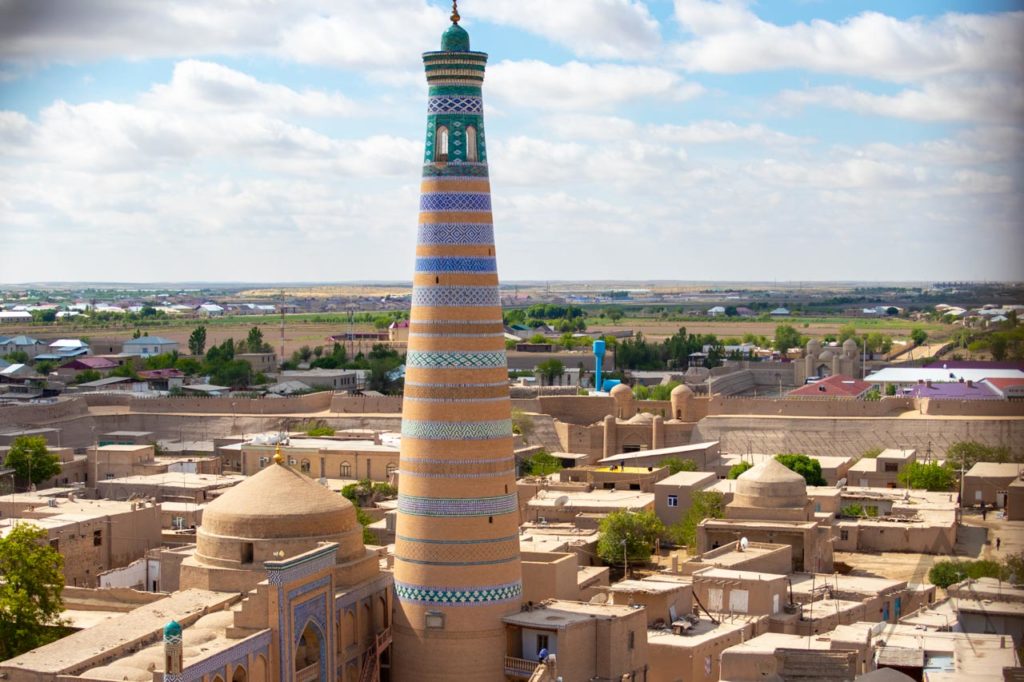Islam Khoja ensemble
Islam Khoja ensemble
Islam Khoja (or Islam Khodja) ensemble contains together the tiniest madrasah and the tallest minaret of Khiva. The ensemble is placed in the south-eastern part of the Ichan-Kala old town. The builders of the minaret wanted to exceed the Bukhara Kalyan minaret and managed to build it up to 57 m plus the base easily surpassing the 48 m of their competitor. The Islam Khodja ensemble was built in 1908-1910 by the command of Islam Khodja, the chief vizier of the Khivan Khanate under Muhammad Rakhim-khan II (1863-1910) and his son Isfandiyar-khan (1910-1920).
Islam Khodja
While Khiva entered the 20th centurey, an urgent need for reforms was needed and at the culling edge of these reforms was the Grand Vizier, Islam Khodja, who quickly gained the respect of the people by employing a public school and hospital and the wrath of the clergy by initiating a series of educational reforms. Under his progressive rule, a European-style school was built, long-distance telegraph brought to the city and a hospital built. Islam Khodja was though assassinated on the command of his arch-enemy Nazar Beg in 1913.
Islam Khoja Minaret
The Islam Khodja minaret is standing proud and is harmonious shape, surrounded with sparkling tapes of mosaic facings and it became fast the most striking symbol of Ichan-Kala at the time of its construction. The minaret’s top platform at a height of 45 m is the highest point from which to obtain a panoramic view of Khiva.
The trunk of the Islam Khodja minaret, having a diameter of 9,5 m at the base, is reduced as it climbs higher. The brick decoration of the Islam Khodja minaret underlines its monumentality.
The minaret is girded by sparkling strips of facings of glazed patterns, mainly of blue, dark blue, white and turquoise colors, the ornaments of which are unique. Regarding beauty and grace, only the Kalyan minaret in Bukhara can be compared to this minaret, which was conceived much earlier than the Islam Khodja minaret.

Islam Khoja Madrassa
Islam Khodja madrasah occupies an essential spot in the Ichan-Kala ensemble, serving as a background to the Islam Khodja minaret with its adjoining main facade. Its small courtyard was constructed with 42 single-story hudzhras. The second floor includes only the entrance group and is decorated with a magnificent majolica facade. Dark-blue-white majolica facings, tympanums and glazed pattern strips are used in the decor of the madrasah’s main facade. The madrasah’s south-eastern part has an enormous low dome. This madrasah is a unique architectural construction, that reveals the influence of time and the national masters’ spirit of creative inspiration.
Masters Bolta Vaisov and Madiminov carried out the madrasah’s glaze decoration based on Ishmukham-mad Khudaiberdiev’s sketches. The architects’ and masters’ skills are visible in the architectural forms which contrast the combinations, skilfully used on the limited space. The mikhrob (prayer niche in the mosque wall, facing Mecca) is finished with majolica and a carved gunch. The 42 rooms of the madrassah now hold a museum of applied arts, displaying local arts ranging from women’s embroidered chetvan robes to the original carved wooden plaque of the Ota Darvoza. Metal-chasing and leatherwork, tile and ganch and marble and wood carvings are all represented. The mosque is crowned with a characteristically Persian-shaped dome.
In front of the madrassah there is the first Russian school built in Khiva (1912), which today houses a small exhibition devoted to Uzbekistan’s first photographer Khudaybergon Devanov (1879-1940). For some time Devanov was the official photographer of Muhammed Rakhim Khan, providing him unparalleled access. The wonderful images reveal an uneasy mingling of the ancient and the Soviet, from portraits of khans to political meetings, all developed from enormous glass negatives.
Sights of Khiva
Page updated 18.2.2021